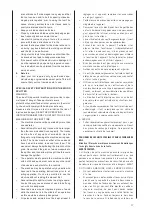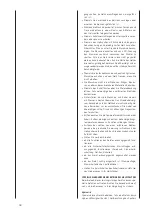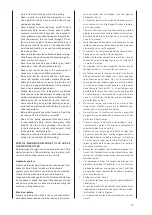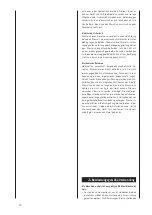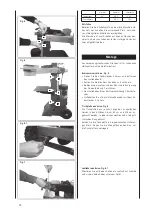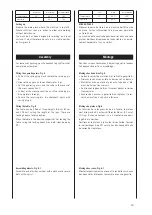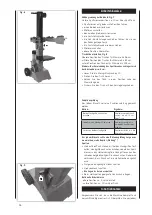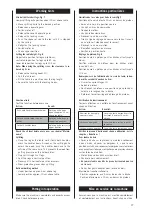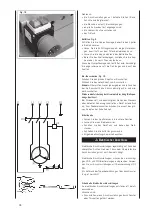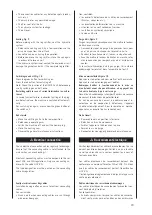
15
•
Un moment d inattention pendant l utilisation de l
outil électrique peut entraîner des blessures graves.
•
Portez un équipement de protection personnel et
toujours des lunettes de protection.
•
Le port d un équipement de protection personnel
comme un masque anti-poussière, des chaussures
de sécurité antidérapantes, un casque de sécurité
ou une protection de l ouïe, en fonction du type et
de l emploi de l outil électrique, diminue le risque
de blessures.
•
Portez une protection de l ouïe.
•
L exposition au bruit peut entraîner une perte de
l ouïe.
•
Portez un masque anti-poussière.
•
Lors de travaux sur su bois et autres matériaux, de
la poussière nuisible à la santé peut être dégagée.
Ne travaillez pas sur du matériau contenant de l
amiante !
•
Portez des lunettes de protection.
•
Les étincelles générées pendant travail ou les éclats,
copeaux et la poussière sortant de lʼappareil peuvent
entraîner une perte de la vue.
•
Evitez une mise en service par mégarde. Assurez-
vous que l interrupteur est bien en position “HORS
CIRCUIT” avant de mettre la fiche dans la prise.
•
Si vous portez l appareil en gardant le doigt sur l
interrupteur ou raccordez l appareil à l alimentation
réseau alors qu il est en position en circuit, cela
peut entraîner des accidents.
•
Supprimez les outils de réglage ou les tournevis
avant de mettre l appareil en circuit.
•
Un outil ou une clé laissée dans une pièce de l
appareil en rotation peut entraîner des blessures.
•
Ne vous surestimez pas. Veillez à vous tenir de façon
sûre et gardez à tout moment l équilibre.
•
Vous pourrez ainsi mieux contrôler l appareil dans
les situations inattendues.
•
Portez une tenue appropriée. Ne portez aucun vête-
ment ou bijou lâche. Gardez les cheveux, vêtements
et gants à distance des pièces en mouvement.
•
Des vêtements, des bijoux lâches ou de longs che-
veux peuvent être saisis par des pièces en mouve-
ment.
•
Lorsque vous pouvez monter des dispositifs d aspira-
tion de la poussière et des dispositifs de collecte de
la poussière, assurez-vous quʼils sont bien raccordés
et correctement employés.
•
L utilisation de ces dispositifs diminue les risques
entraînés par la poussière.
4. MANIPULATION ET EMPLOI MINUTIEUX DES OUTILS ELEC-
TRIQUES
•
Ne surchargez pas votre outil. Utilisez l outil élec-
trique adéquat pour votre travail.
•
Vous travaillerez mieux et plus sûrement dans la
plage de performance donnée si vous utilisez les
outils électriques convenables.
•
N utilisez pas d outil électrique dont l interrupteur
est défectueux.
•
Un outil électrique impossible à mettre en ou hors
circuit est dangereux doit être réparé.
•
Retirez la fiche de la prise avant de réaliser des
tool and the particular application) reduces the risk
of sustaining injury.
•
Wear ear-muffs.
•
The impact of noise can cause damage to hearing.
•
Wear a breathing mask.
•
Dust which is injurious to health can be generated
when working on wood and other materials. Never
use the device to work on any materials containing
asbestos!
•
Wear safety goggles.
•
Sparks generated during working or splinters,
chips and dust emitted by the device can cause
loss of sight.
•
Avoid unintentional startups. Ensure that the switch
is in the “OFF” position before you insert the plug
into the socket outlet.
•
Physically touching the switch with your finger
when carrying the tool or connecting the tool to the
power supply switched on can lead to accidents.
•
Remove adjusting tools/wrench(es) prior to swit-
ching on the power tool.
•
A tool or wrench that is positioned inside a rotating
power tool part can cause injury.
•
Do not overestimate your abilities. Make sure you
stand squarely and keep your balance at all times.
•
This way, you will be able to have better control
over the tool in unexpected situations.
•
Wear suitable clothes. Never wear loose fitting clo-
thes or jewelry. Keep hair, clothes and gloves away
from moving parts.
•
Loose clothing, dangling jewelry and long hair can
be caught by moving parts.
•
If dust extraction and dust collection devices can
be mounted, ensure that these are connected and
are properly used.
•
Use of such equipment reduces the risk associated
with dust accumulation.
4. CAREFUL HANDLING AND USE OF ELECTRIC
TOOLS
•
Do not overload your tool. Only use suitable elec-
tric tools to perform your work.
•
Using the right electric tool allows you to work
better and safer within the tool s quoted capacity
range.
•
Do not use an electric tool whose switch is de-
fective.
•
An electric tool that no longer can be switched on
or off is dangerous and must be repaired.
•
Always pull the plug out of the socket outlet befo-
re making any adjustments. Exchange accessory
parts or put away the tool.
•
This precaution eliminates the possibility of inad-
vertently starting the tool.
•
When not in use, store electric tools out of the
reach of children. Do not allow those persons to
use this tool who are unfamiliar with it or who have
not read these instructions.
•
Electric tools are dangerous when they are used
by inexperienced persons.
•
Take good care of your tool. Check that moving
parts properly function and do not jam, that parts

















